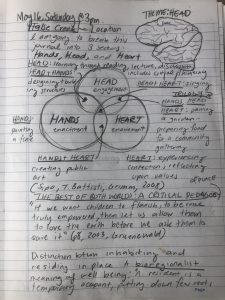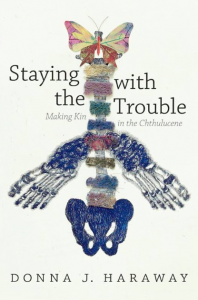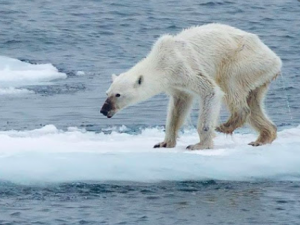Philosophy
Philosophy of place and teaching in nature
“If we want children to flourish, to become truly empowered, then let us allow them to love the earth before we ask them to save it” -David Gruenwald
“Environmental education is sometimes seen as very focused on problems or issues, with limited attention to the beauty, opportunity, and surprises to be found in both natural and built environments. There is a need to ensure that EE encompasses both the challenges and opportunities, failures, and successes, foolishness, and wisdom to be seen in human-environmental relations” – Milton McClaren
Click here for EDUC 452 journal entry: hands head and heart

Journal Entry, May 16, 2020. I quote Gruenewald, 2013: “If we want children to flourish, to become truly empowered, then let us allow them to love the earth before we ask them to save it” (p. 8)
We are living in during a time of many crises, and arguable the most salient being climate change. Canadian’s throughout history have believed that we can industrialize the planet and exploit all of its resources, releasing greenhouse gas emissions (GHG), with no regard to people and the planet. This colonial lens has predominantly been instilled in pedological paradigms; furthermore, our educational model prescribes the narrative that students should learn how to control their environment, rather than be in harmony with it. In addition to climate change, we are facing species and habitat loss, ocean acidification, environmental degradation, and environmental racism, to name a few. Scholars have said that “education is at odds with sustainability when modern economies function to damage and destroy the ecological systems that support human and non-human communities” (Sipos, Battisti, Grimm, 2007, p.69). We all know this! In contrast, spending time in nature and learning to be in harmony with nature is the antidote to this paradigm. Dr. Janet Moore, Simon Fraser University scholar highlights that the ultimate goal of transformative learning is to empower individuals to change their frames of reference or worldviews (2005). With that in mind, we must change our pedological worldview—embrace harmony and appreciation in nature. My personal philosophy of environmental education is a transformative tool for curating a new worldview. With that in mind, I believe that place-based nature pedagogy is a salient way to foster environmental stewardship rather than promoting ecophobia.
Learning in nature encourages environmental stewardship

Staying with the Trouble, Making Kin in the Chthulucene, Donna J. Haraway
Learning in nature, or “pedagogy of place” (Sauve, 2005, p.19) can “encourage the development of an attachment to nature” (Sauve, 2005, p. 14). In other words, it can help students foster a stronger connection and appreciation of place; thus, as a result, harnessing an appreciation of nature—which will lead to students caring for their environment in the future. Environmental education often focuses on problems with the environment. I am not arguing that it is problematic to learn about the problems. Rather the problems themselves birthed environmental education and awareness of the subject itself. However, I am suggesting that a majority of the focus of environmental education is focused on outlining degradation, tipping points, and systems collapse. Many scholars have argued that we are now in a new epoch called the Anthropocene, which refers to how humans and only humans have influenced the trajectory of our planet’s health due to our beahviours. The influence of anthropogenic causes has actually pushed us into a new era. In Donna J. Haraway’s prolific book, Staying with The Trouble, Making Kin in the Chthulucene she speaks about how human consumption has driven us into a new reality (2016, p.44-56). Exclusive pragmatic pedagogy, with a focus on the cumbersome impacts of this epoch, the Anthropocene—including humans degrading the environment in such a way that has caused species and habitat loss, climate change, and ocean acidification do not inspire students to take action.
The Environmental Education Discourse of Action
I strongly connect with Problem-Solving Current Environmental Education, as it evokes the concept of action being an outcome of environmental education. The objective of teaching environmental education must be an outcome of action. For example, what is the point to teach children about the 5 R’s (Reduce, Reuse, Refuse, Repair, and Recycle) if after the lesson the student continues to consume at a staus-quo rate and, only to use the landfill stream? What is the measurement of success? In the article Currents in Environmental Education: Mapping a Complex and Evolving Pedagogical Field (2005), Lucie Sauvé from the University of Montreal frames the theoretical model of Problem- Solving Current as an inquiry question: “Must environmental education be fundamentally oriented towards problem-solving? Must environmental education necessarily engage learners in action projects aimed at solving a problem? Or is environmental education a preparatory phase for action.” With that in mind, I totally jam with Harold R. Hungerford who designed the model of Problem-Solving Current. He suggests that we must 1) identify a problem 2) investigate and research it (get close to the problem and understand it) 3) diagnose the problem and 4) search for solutions. What Hungerford fundamentally misses with this recipe-for-change (although slightly alluding to in the solutions) is a step 5) where students can actually move their identified problem, research, and solution ideas into a tangible vehicle for change. The question must then be, “what is next?” If we do not push forward to step 5, then we are always complacent with the problem. When status-quo is maintained than no real change is made, and GHG emissions never go down to the 10% decrease we need to get to a 1.5-degree target–for our very own planet’s survival.
Ecophobia
 Students can become overwhelmed by the current paradigm of environmental destruction. Thus, resulting in ecophobia. Ecophobia arises in students feeling powerless in one’s own environment, so as a result, they feel that they cannot make a difference (Estok, 2018). I believe ecophobia is partially a result caused by educators, not providing their students the opportunity to delve into step 4 or 5 in the sequential developed problem-solving environmental education, as discussed above.
Students can become overwhelmed by the current paradigm of environmental destruction. Thus, resulting in ecophobia. Ecophobia arises in students feeling powerless in one’s own environment, so as a result, they feel that they cannot make a difference (Estok, 2018). I believe ecophobia is partially a result caused by educators, not providing their students the opportunity to delve into step 4 or 5 in the sequential developed problem-solving environmental education, as discussed above.
We cannot scare our students into caring for the planet.
To date there are have been 1435 climate emergencies declared in cities across 23 countries (The Climate Mobilization, 2020). We need future change-makers and leaders who will steward the planet and participate in the changes necessary to curb GHG emissions. However, we will not achieve this by scaring children and youth. For example, the quintessential image of climate change is that of the famous skinny and desperate polar bear stranded on a melting glacier, which I see so often used as a tool of ‘conveying the message’ in elementary and high school classrooms. This image does not motivate students, rather it overwhelms them.
Research shows that the best way for students to take leadership for their environment is to provide opportunities for them to be in nature. Spending time in nature indirectly will create respect and appreciation of nature. In the article A Competence Model for Environmental Education (2013), the author suggests that students attitude towards nature can be influenced by spending time in nature and that there is a direct correlation between spending time in nature and “adolescents embark[ing] ecological lifestyles” (Roczen, Kaiser, Bogner, et al., 2014, p. 986). Thus, the most salient form of environmental education is place-based outdoor education in nature. Hence circling back to the opening line of this paragraph describing the ‘pedagogy of place.’ Bringing students outside to learn in nature, in turn, will result in students who care about the environment.
Proving place-based natural pedagogical opportunities for students can result in environmental stewardship. It is the educational compass that I look to view pedagogical modalities through and deep-seated philosophy that we must teach environmental education as our planet is currently in a climate crisis. Navigating this crisis through an exclusive pragmatic cumbersome delivery (i.e., utilizing only the head), is not enough. New knowledge does not necessarily correlate to environmental action. Some of the most educated people in our society are the largest polluters. We all know this!
The lens we must adopt is transformative education. And it can only be achieved by providing our students will opportunities to be outside in nature. To this point, “if our collective goal is a more sustainable present and future, we must manifest, encourage, and impart values that contribute towards that goal. (Sipos, Battisti & Grimm, 2007, p. 70,). We must change how we interact with nature, and as educators, we can cultivate nature as a tool that will result in future stewards of this planet. A steward that has adopted a new worldview, one that places nature and respect at the forefront.
Sources that contributed to philosophy
Climate Emergency. (2020, May 14). Retrieved June 14, 2020, from https://www.theclimatemobilization.org/climate-emergency/
Estok, & C, S. (2018). The Ecophobia Hypothesis (1st ed.). Milton: Routledge Ltd. doi:10.4324/9781315144689
Haraway, D. J., & e-Duke Books Scholarly Collection 2016. (2016). Staying with the Trouble: Making Kin in the Chthulucene. Durham: Duke University Press.
Moore, J. (2005). Barriers and Pathways to Creating Sustainability Education Programs: Policy, Rhetoric and Reality. Environmental Education Research, 11(5), 537-555. doi:10.1080/13504620500169692
Roczen, N., Kaiser, F. G., Bogner, F. X., & Wilson, M. (2014). A Competence Model for Environmental Education. Environment and Behavior, 46(8), 972-992. doi:10.1177/0013916513492416
Sauve, L. (2005). Currents in environmental education: Mapping a complex and evolving pedagogical field. Canadian Journal of Environmental Education, 10(1), 11.
Sipos, Y., Battisti, B., & Grimm, K. (2008). Achieving Transformative Sustainability Learning: Engaging Head, Hands and Heart. International Journal of Sustainability in Higher Education, 9(1), 68-86. doi:10.1108/14676370810842193
White, M. P., Alcock, I., Grellier, J., Wheeler, B. W., Hartig, T., Warber, S. L., . . . Samhällsvetenskapliga fakulteten. (2019). Spending at least 120 minutes a week in nature is associated with good health and wellbeing. Scientific Reports, 9(1), 7730-11. doi:10.1038/s41598-019-44097-3